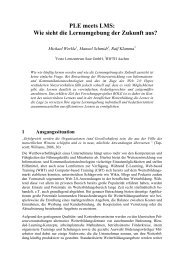Customized PLE implementations for test-bed scenario ... - ROLE
Customized PLE implementations for test-bed scenario ... - ROLE
Customized PLE implementations for test-bed scenario ... - ROLE
Create successful ePaper yourself
Turn your PDF publications into a flip-book with our unique Google optimized e-Paper software.
container solution into the existing infrastructure. Users can link and mash data in the<br />
Knowledge Map and the Wiki. Furthermore, inter-system interoperability and activity<br />
flows are supported by these tools.<br />
Besides the first work on capturing learner interactions in the <strong>for</strong>m of CAM data, no<br />
other protocols or specifications of <strong>ROLE</strong> are used. So, this <strong>test</strong>-<strong>bed</strong> relies on XMPP<br />
and PMRPC (service design), XML and JSON (data representation and <strong>for</strong>mats), and<br />
XMPP and Event API (communication between systems). No standardisation has been<br />
or will be addressed concerning structuring user and content data, digital rights<br />
management, the description of learning resources, and the management of user data<br />
and profiles. Moreover, widget technology has been brought into the <strong>test</strong>-<strong>bed</strong>. User<br />
interactions are recorded in the <strong>for</strong>m of CAM data and, on a lower level, as log files.<br />
This data is analysed but not used <strong>for</strong> more sophisticated features like<br />
recommendations or practice sharing. User profiles are stored on a LDAP server in a<br />
minimalistic variant (unique identifier and data necessary <strong>for</strong> authentication). The<br />
identifier and authentication is used by all tools but learners cannot modify their profiles.<br />
Privacy restrictions are only given by law.<br />
The primary <strong>scenario</strong> <strong>for</strong> using learning tools deals with project tasks within a lecture.<br />
Here, students can use the tools provided within the <strong>test</strong>-<strong>bed</strong> to collaboratively work on<br />
a small project in which theoretical issues of the lecture have to be applied in a practical<br />
setting. Typically, the Web 2.0 Knowledge Map application provides the content of the<br />
lecture in a structured way and gives background in<strong>for</strong>mation on the topics.<br />
Furthermore, learners can generate in the Wiki and share new content through the<br />
Knowledge Map.<br />
Finally and regarding the development perspective, new technical learning solutions<br />
are realised by researchers and developers at RWTH. For instance, the Web 2.0<br />
Knowledge Map is an outcome of a <strong>for</strong>mer project called WeKnow. Thereby, learners<br />
are involved into the development process in terms of requirements gathering (surveys,<br />
learner feedback) and user <strong>test</strong>s (utility, usability). Due to collaborative projects by<br />
RWTH, external stakeholders in the development process of learning technology mainly<br />
comprise researchers from other organisations who can bring in new concepts and<br />
prototypes if being considered useful by the <strong>test</strong>-<strong>bed</strong> responsible.<br />
New technology can be integrated on behalf of the <strong>test</strong>-<strong>bed</strong> responsible, as already<br />
shown with various approaches (widgetisation of the Knowledge Map, integration of a<br />
widget container and two <strong>ROLE</strong> gadgets, etc). Learners, however, cannot bring in new<br />
tools into the learning environment. Beside the tools given in the <strong>test</strong>-<strong>bed</strong>, RWTH does<br />
not have an own tool repository. The success of technical learning solutions is<br />
evaluated through surveys at the end of each semester. The feedback on the existing<br />
tools is mainly positive.<br />
Results from the Christmas, the Easter, and the Stonehenge Project<br />
In the Christmas Project, the chat and the CAM widget were firstly developed. However,<br />
these tools have not been used within the <strong>test</strong>-<strong>bed</strong>, as there was no lecture at this time.<br />
The Easter Project led to an implementation and introduction of a widget container <strong>for</strong><br />
the RWTH learning plat<strong>for</strong>m. By using this container the three be<strong>for</strong>e-mentioned<br />
Page 32 of 102



